Business Law and Employment Law: V-Engines Case Study Report
VerifiedAdded on 2022/12/26
|11
|2722
|89
Report
AI Summary
This report delves into business and employment law, crucial for understanding the legal framework governing business operations and employee rights. It begins with an introduction to business and employment law, emphasizing their importance in establishing order and protecting rights within organizations. The report then analyzes different business types, including sole proprietorships, partnerships, corporations, and limited liability companies (LLCs), outlining their advantages and disadvantages. A case study involving a small business owner, Homer, and his V-Engines company, is presented to illustrate the practical implications of these legal structures. The report also explores the duties of directors, as defined by the Companies Act 2006, and examines employment law, focusing on the Health and Safety at Work Act 1974 and the Equality Act 2010. It highlights the significance of these laws in ensuring employee safety and preventing discrimination. The conclusion summarizes the key findings and reinforces the importance of business and employment law in the successful operation of a business.
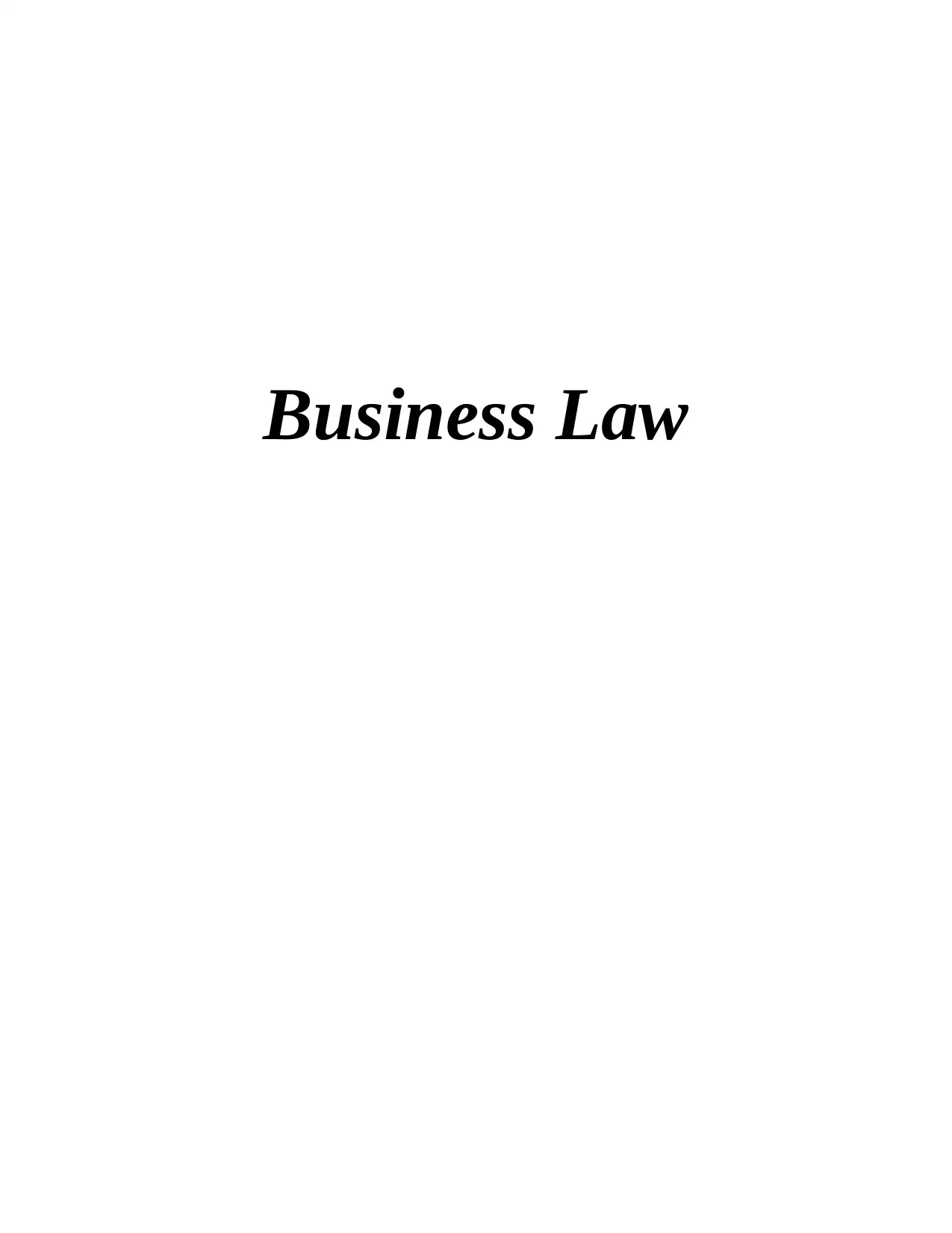
Business Law
Paraphrase This Document
Need a fresh take? Get an instant paraphrase of this document with our AI Paraphraser
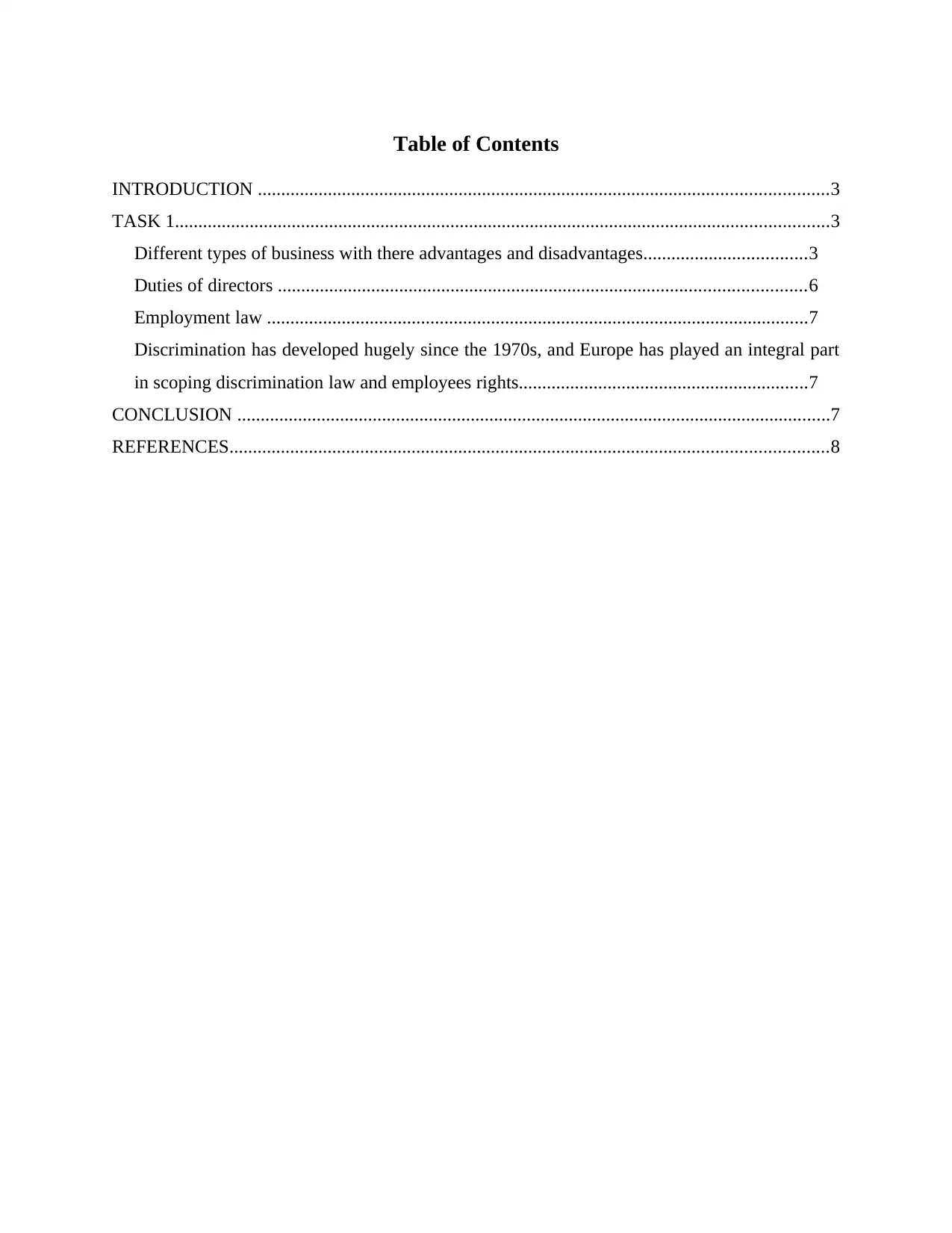
Table of Contents
INTRODUCTION ..........................................................................................................................3
TASK 1............................................................................................................................................3
Different types of business with there advantages and disadvantages...................................3
Duties of directors .................................................................................................................6
Employment law ....................................................................................................................7
Discrimination has developed hugely since the 1970s, and Europe has played an integral part
in scoping discrimination law and employees rights..............................................................7
CONCLUSION ...............................................................................................................................7
REFERENCES................................................................................................................................8
INTRODUCTION ..........................................................................................................................3
TASK 1............................................................................................................................................3
Different types of business with there advantages and disadvantages...................................3
Duties of directors .................................................................................................................6
Employment law ....................................................................................................................7
Discrimination has developed hugely since the 1970s, and Europe has played an integral part
in scoping discrimination law and employees rights..............................................................7
CONCLUSION ...............................................................................................................................7
REFERENCES................................................................................................................................8
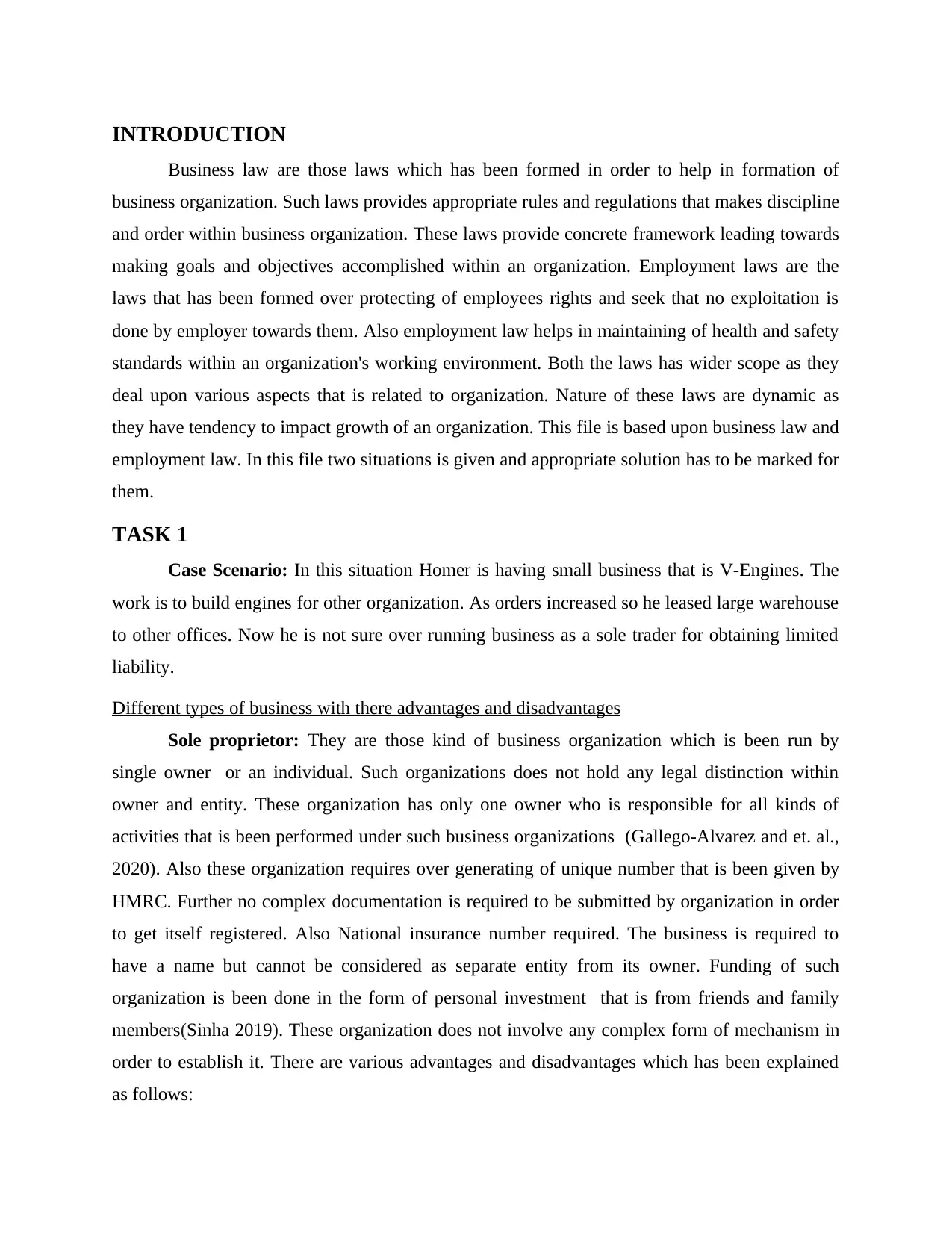
INTRODUCTION
Business law are those laws which has been formed in order to help in formation of
business organization. Such laws provides appropriate rules and regulations that makes discipline
and order within business organization. These laws provide concrete framework leading towards
making goals and objectives accomplished within an organization. Employment laws are the
laws that has been formed over protecting of employees rights and seek that no exploitation is
done by employer towards them. Also employment law helps in maintaining of health and safety
standards within an organization's working environment. Both the laws has wider scope as they
deal upon various aspects that is related to organization. Nature of these laws are dynamic as
they have tendency to impact growth of an organization. This file is based upon business law and
employment law. In this file two situations is given and appropriate solution has to be marked for
them.
TASK 1
Case Scenario: In this situation Homer is having small business that is V-Engines. The
work is to build engines for other organization. As orders increased so he leased large warehouse
to other offices. Now he is not sure over running business as a sole trader for obtaining limited
liability.
Different types of business with there advantages and disadvantages
Sole proprietor: They are those kind of business organization which is been run by
single owner or an individual. Such organizations does not hold any legal distinction within
owner and entity. These organization has only one owner who is responsible for all kinds of
activities that is been performed under such business organizations (Gallego‐Alvarez and et. al.,
2020). Also these organization requires over generating of unique number that is been given by
HMRC. Further no complex documentation is required to be submitted by organization in order
to get itself registered. Also National insurance number required. The business is required to
have a name but cannot be considered as separate entity from its owner. Funding of such
organization is been done in the form of personal investment that is from friends and family
members(Sinha 2019). These organization does not involve any complex form of mechanism in
order to establish it. There are various advantages and disadvantages which has been explained
as follows:
Business law are those laws which has been formed in order to help in formation of
business organization. Such laws provides appropriate rules and regulations that makes discipline
and order within business organization. These laws provide concrete framework leading towards
making goals and objectives accomplished within an organization. Employment laws are the
laws that has been formed over protecting of employees rights and seek that no exploitation is
done by employer towards them. Also employment law helps in maintaining of health and safety
standards within an organization's working environment. Both the laws has wider scope as they
deal upon various aspects that is related to organization. Nature of these laws are dynamic as
they have tendency to impact growth of an organization. This file is based upon business law and
employment law. In this file two situations is given and appropriate solution has to be marked for
them.
TASK 1
Case Scenario: In this situation Homer is having small business that is V-Engines. The
work is to build engines for other organization. As orders increased so he leased large warehouse
to other offices. Now he is not sure over running business as a sole trader for obtaining limited
liability.
Different types of business with there advantages and disadvantages
Sole proprietor: They are those kind of business organization which is been run by
single owner or an individual. Such organizations does not hold any legal distinction within
owner and entity. These organization has only one owner who is responsible for all kinds of
activities that is been performed under such business organizations (Gallego‐Alvarez and et. al.,
2020). Also these organization requires over generating of unique number that is been given by
HMRC. Further no complex documentation is required to be submitted by organization in order
to get itself registered. Also National insurance number required. The business is required to
have a name but cannot be considered as separate entity from its owner. Funding of such
organization is been done in the form of personal investment that is from friends and family
members(Sinha 2019). These organization does not involve any complex form of mechanism in
order to establish it. There are various advantages and disadvantages which has been explained
as follows:
⊘ This is a preview!⊘
Do you want full access?
Subscribe today to unlock all pages.

Trusted by 1+ million students worldwide
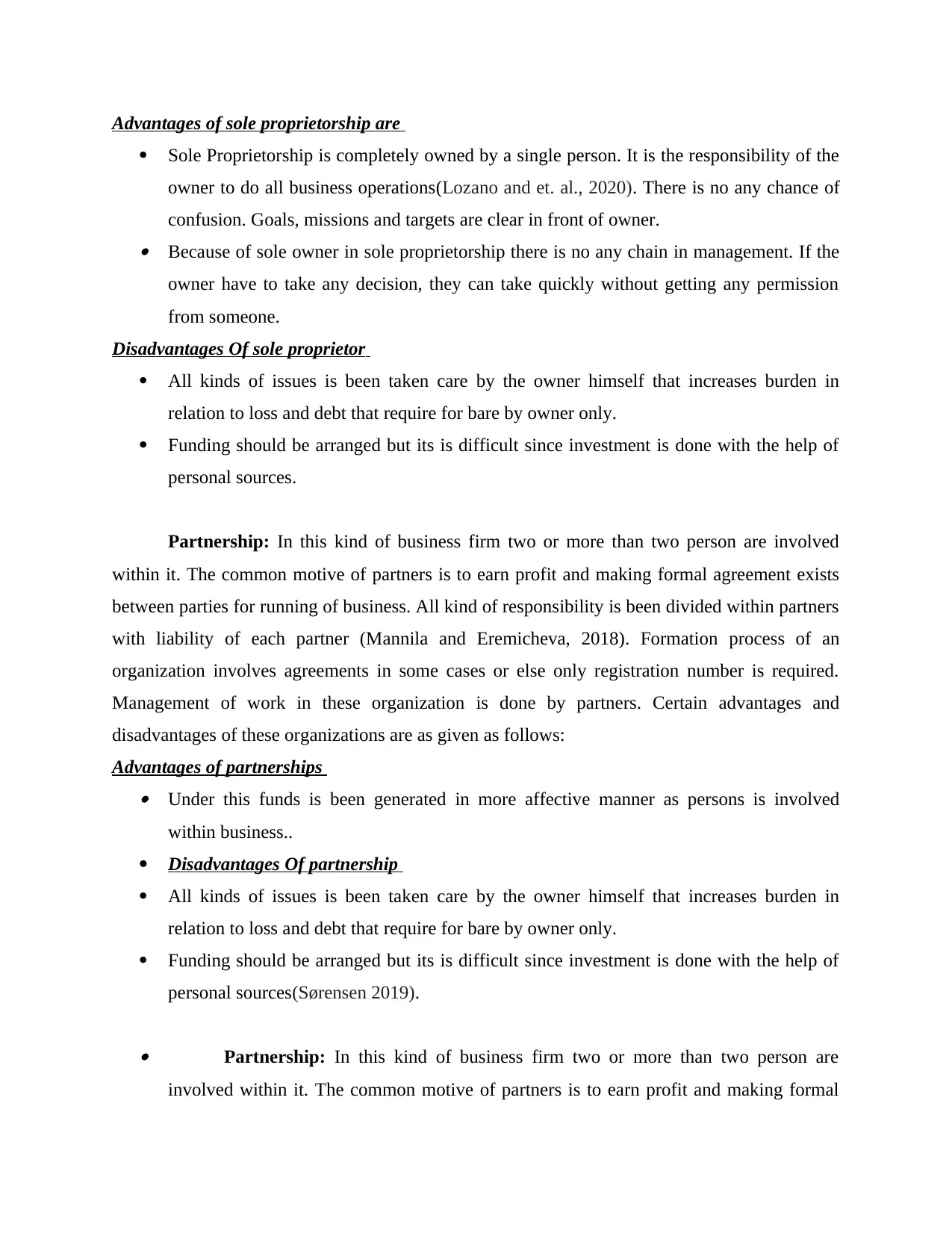
Advantages of sole proprietorship are
Sole Proprietorship is completely owned by a single person. It is the responsibility of the
owner to do all business operations(Lozano and et. al., 2020). There is no any chance of
confusion. Goals, missions and targets are clear in front of owner. Because of sole owner in sole proprietorship there is no any chain in management. If the
owner have to take any decision, they can take quickly without getting any permission
from someone.
Disadvantages Of sole proprietor
All kinds of issues is been taken care by the owner himself that increases burden in
relation to loss and debt that require for bare by owner only.
Funding should be arranged but its is difficult since investment is done with the help of
personal sources.
Partnership: In this kind of business firm two or more than two person are involved
within it. The common motive of partners is to earn profit and making formal agreement exists
between parties for running of business. All kind of responsibility is been divided within partners
with liability of each partner (Mannila and Eremicheva, 2018). Formation process of an
organization involves agreements in some cases or else only registration number is required.
Management of work in these organization is done by partners. Certain advantages and
disadvantages of these organizations are as given as follows:
Advantages of partnerships Under this funds is been generated in more affective manner as persons is involved
within business..
Disadvantages Of partnership
All kinds of issues is been taken care by the owner himself that increases burden in
relation to loss and debt that require for bare by owner only.
Funding should be arranged but its is difficult since investment is done with the help of
personal sources(Sørensen 2019).
Partnership: In this kind of business firm two or more than two person are
involved within it. The common motive of partners is to earn profit and making formal
Sole Proprietorship is completely owned by a single person. It is the responsibility of the
owner to do all business operations(Lozano and et. al., 2020). There is no any chance of
confusion. Goals, missions and targets are clear in front of owner. Because of sole owner in sole proprietorship there is no any chain in management. If the
owner have to take any decision, they can take quickly without getting any permission
from someone.
Disadvantages Of sole proprietor
All kinds of issues is been taken care by the owner himself that increases burden in
relation to loss and debt that require for bare by owner only.
Funding should be arranged but its is difficult since investment is done with the help of
personal sources.
Partnership: In this kind of business firm two or more than two person are involved
within it. The common motive of partners is to earn profit and making formal agreement exists
between parties for running of business. All kind of responsibility is been divided within partners
with liability of each partner (Mannila and Eremicheva, 2018). Formation process of an
organization involves agreements in some cases or else only registration number is required.
Management of work in these organization is done by partners. Certain advantages and
disadvantages of these organizations are as given as follows:
Advantages of partnerships Under this funds is been generated in more affective manner as persons is involved
within business..
Disadvantages Of partnership
All kinds of issues is been taken care by the owner himself that increases burden in
relation to loss and debt that require for bare by owner only.
Funding should be arranged but its is difficult since investment is done with the help of
personal sources(Sørensen 2019).
Partnership: In this kind of business firm two or more than two person are
involved within it. The common motive of partners is to earn profit and making formal
Paraphrase This Document
Need a fresh take? Get an instant paraphrase of this document with our AI Paraphraser
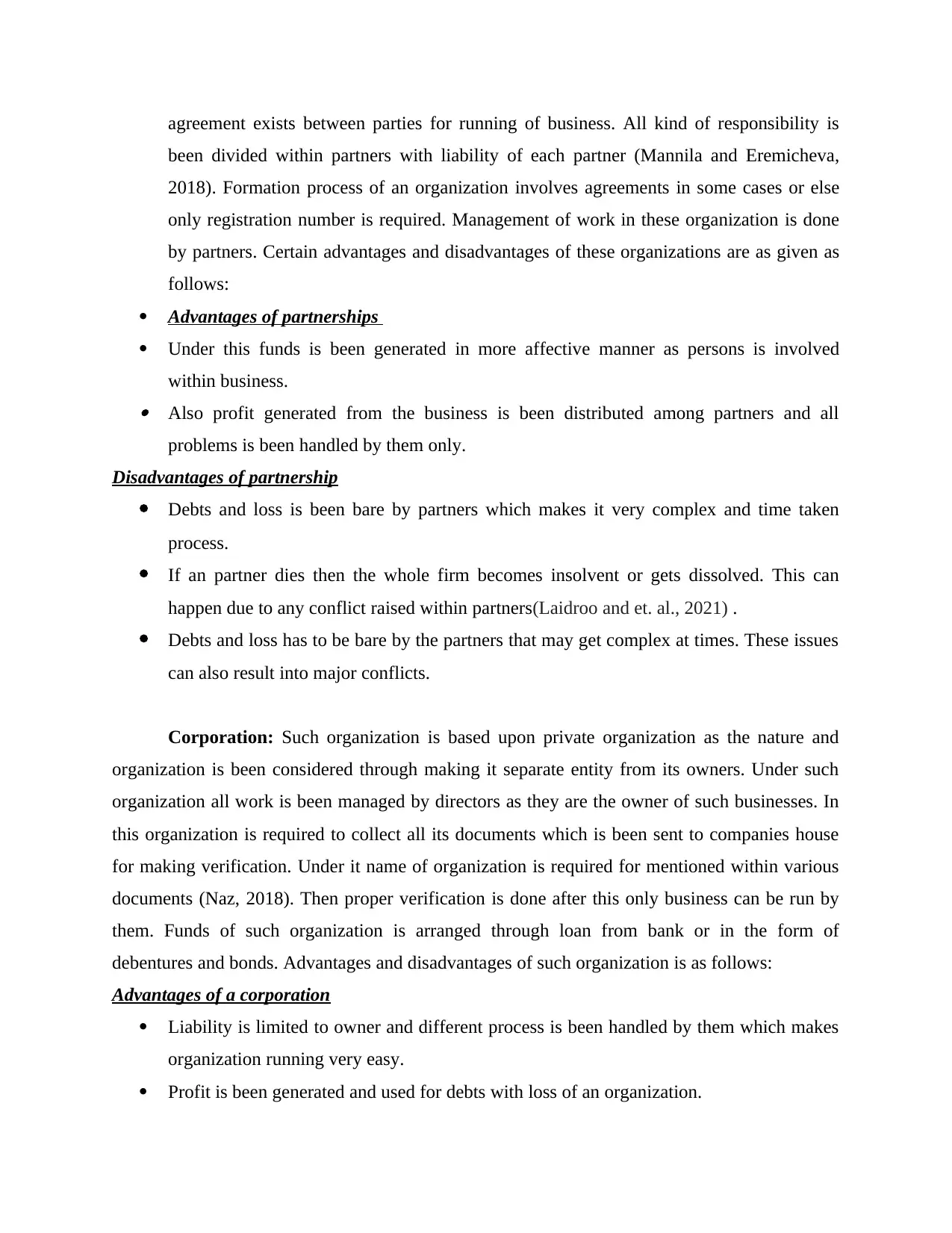
agreement exists between parties for running of business. All kind of responsibility is
been divided within partners with liability of each partner (Mannila and Eremicheva,
2018). Formation process of an organization involves agreements in some cases or else
only registration number is required. Management of work in these organization is done
by partners. Certain advantages and disadvantages of these organizations are as given as
follows:
Advantages of partnerships
Under this funds is been generated in more affective manner as persons is involved
within business. Also profit generated from the business is been distributed among partners and all
problems is been handled by them only.
Disadvantages of partnership
Debts and loss is been bare by partners which makes it very complex and time taken
process.
If an partner dies then the whole firm becomes insolvent or gets dissolved. This can
happen due to any conflict raised within partners(Laidroo and et. al., 2021) .
Debts and loss has to be bare by the partners that may get complex at times. These issues
can also result into major conflicts.
Corporation: Such organization is based upon private organization as the nature and
organization is been considered through making it separate entity from its owners. Under such
organization all work is been managed by directors as they are the owner of such businesses. In
this organization is required to collect all its documents which is been sent to companies house
for making verification. Under it name of organization is required for mentioned within various
documents (Naz, 2018). Then proper verification is done after this only business can be run by
them. Funds of such organization is arranged through loan from bank or in the form of
debentures and bonds. Advantages and disadvantages of such organization is as follows:
Advantages of a corporation
Liability is limited to owner and different process is been handled by them which makes
organization running very easy.
Profit is been generated and used for debts with loss of an organization.
been divided within partners with liability of each partner (Mannila and Eremicheva,
2018). Formation process of an organization involves agreements in some cases or else
only registration number is required. Management of work in these organization is done
by partners. Certain advantages and disadvantages of these organizations are as given as
follows:
Advantages of partnerships
Under this funds is been generated in more affective manner as persons is involved
within business. Also profit generated from the business is been distributed among partners and all
problems is been handled by them only.
Disadvantages of partnership
Debts and loss is been bare by partners which makes it very complex and time taken
process.
If an partner dies then the whole firm becomes insolvent or gets dissolved. This can
happen due to any conflict raised within partners(Laidroo and et. al., 2021) .
Debts and loss has to be bare by the partners that may get complex at times. These issues
can also result into major conflicts.
Corporation: Such organization is based upon private organization as the nature and
organization is been considered through making it separate entity from its owners. Under such
organization all work is been managed by directors as they are the owner of such businesses. In
this organization is required to collect all its documents which is been sent to companies house
for making verification. Under it name of organization is required for mentioned within various
documents (Naz, 2018). Then proper verification is done after this only business can be run by
them. Funds of such organization is arranged through loan from bank or in the form of
debentures and bonds. Advantages and disadvantages of such organization is as follows:
Advantages of a corporation
Liability is limited to owner and different process is been handled by them which makes
organization running very easy.
Profit is been generated and used for debts with loss of an organization.
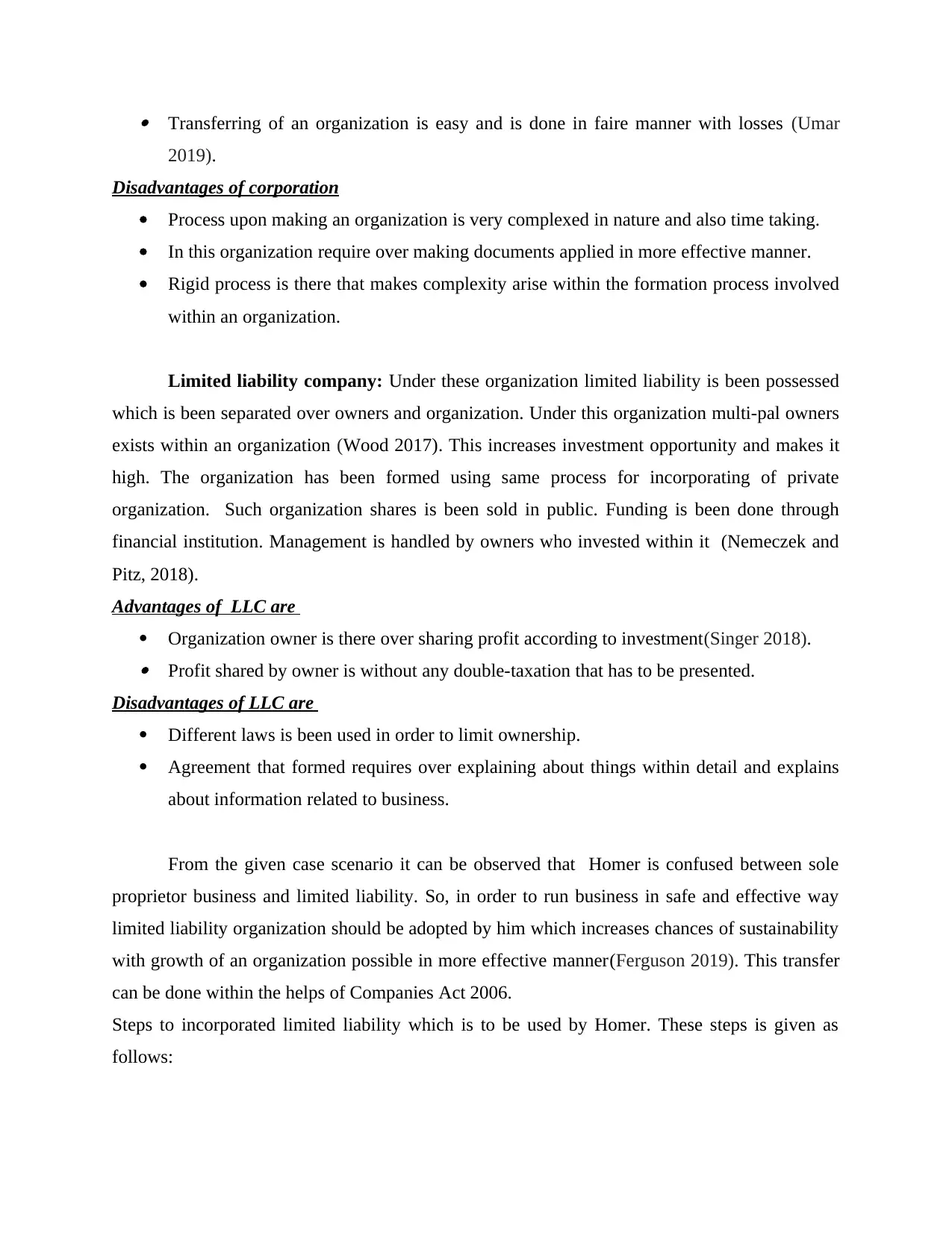
Transferring of an organization is easy and is done in faire manner with losses (Umar
2019).
Disadvantages of corporation
Process upon making an organization is very complexed in nature and also time taking.
In this organization require over making documents applied in more effective manner.
Rigid process is there that makes complexity arise within the formation process involved
within an organization.
Limited liability company: Under these organization limited liability is been possessed
which is been separated over owners and organization. Under this organization multi-pal owners
exists within an organization (Wood 2017). This increases investment opportunity and makes it
high. The organization has been formed using same process for incorporating of private
organization. Such organization shares is been sold in public. Funding is been done through
financial institution. Management is handled by owners who invested within it (Nemeczek and
Pitz, 2018).
Advantages of LLC are
Organization owner is there over sharing profit according to investment(Singer 2018). Profit shared by owner is without any double-taxation that has to be presented.
Disadvantages of LLC are
Different laws is been used in order to limit ownership.
Agreement that formed requires over explaining about things within detail and explains
about information related to business.
From the given case scenario it can be observed that Homer is confused between sole
proprietor business and limited liability. So, in order to run business in safe and effective way
limited liability organization should be adopted by him which increases chances of sustainability
with growth of an organization possible in more effective manner(Ferguson 2019). This transfer
can be done within the helps of Companies Act 2006.
Steps to incorporated limited liability which is to be used by Homer. These steps is given as
follows:
2019).
Disadvantages of corporation
Process upon making an organization is very complexed in nature and also time taking.
In this organization require over making documents applied in more effective manner.
Rigid process is there that makes complexity arise within the formation process involved
within an organization.
Limited liability company: Under these organization limited liability is been possessed
which is been separated over owners and organization. Under this organization multi-pal owners
exists within an organization (Wood 2017). This increases investment opportunity and makes it
high. The organization has been formed using same process for incorporating of private
organization. Such organization shares is been sold in public. Funding is been done through
financial institution. Management is handled by owners who invested within it (Nemeczek and
Pitz, 2018).
Advantages of LLC are
Organization owner is there over sharing profit according to investment(Singer 2018). Profit shared by owner is without any double-taxation that has to be presented.
Disadvantages of LLC are
Different laws is been used in order to limit ownership.
Agreement that formed requires over explaining about things within detail and explains
about information related to business.
From the given case scenario it can be observed that Homer is confused between sole
proprietor business and limited liability. So, in order to run business in safe and effective way
limited liability organization should be adopted by him which increases chances of sustainability
with growth of an organization possible in more effective manner(Ferguson 2019). This transfer
can be done within the helps of Companies Act 2006.
Steps to incorporated limited liability which is to be used by Homer. These steps is given as
follows:
⊘ This is a preview!⊘
Do you want full access?
Subscribe today to unlock all pages.

Trusted by 1+ million students worldwide
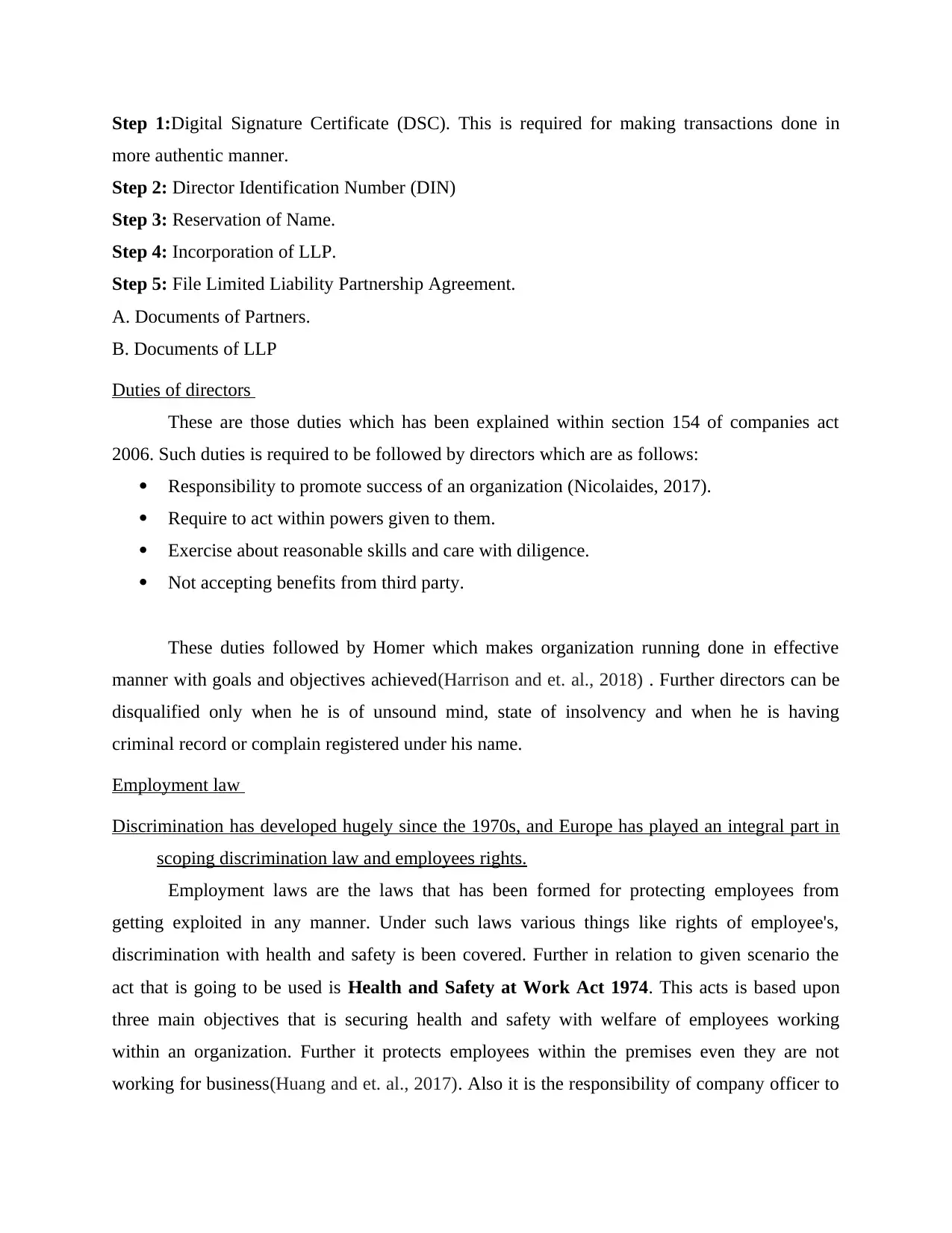
Step 1:Digital Signature Certificate (DSC). This is required for making transactions done in
more authentic manner.
Step 2: Director Identification Number (DIN)
Step 3: Reservation of Name.
Step 4: Incorporation of LLP.
Step 5: File Limited Liability Partnership Agreement.
A. Documents of Partners.
B. Documents of LLP
Duties of directors
These are those duties which has been explained within section 154 of companies act
2006. Such duties is required to be followed by directors which are as follows:
Responsibility to promote success of an organization (Nicolaides, 2017).
Require to act within powers given to them.
Exercise about reasonable skills and care with diligence.
Not accepting benefits from third party.
These duties followed by Homer which makes organization running done in effective
manner with goals and objectives achieved(Harrison and et. al., 2018) . Further directors can be
disqualified only when he is of unsound mind, state of insolvency and when he is having
criminal record or complain registered under his name.
Employment law
Discrimination has developed hugely since the 1970s, and Europe has played an integral part in
scoping discrimination law and employees rights.
Employment laws are the laws that has been formed for protecting employees from
getting exploited in any manner. Under such laws various things like rights of employee's,
discrimination with health and safety is been covered. Further in relation to given scenario the
act that is going to be used is Health and Safety at Work Act 1974. This acts is based upon
three main objectives that is securing health and safety with welfare of employees working
within an organization. Further it protects employees within the premises even they are not
working for business(Huang and et. al., 2017). Also it is the responsibility of company officer to
more authentic manner.
Step 2: Director Identification Number (DIN)
Step 3: Reservation of Name.
Step 4: Incorporation of LLP.
Step 5: File Limited Liability Partnership Agreement.
A. Documents of Partners.
B. Documents of LLP
Duties of directors
These are those duties which has been explained within section 154 of companies act
2006. Such duties is required to be followed by directors which are as follows:
Responsibility to promote success of an organization (Nicolaides, 2017).
Require to act within powers given to them.
Exercise about reasonable skills and care with diligence.
Not accepting benefits from third party.
These duties followed by Homer which makes organization running done in effective
manner with goals and objectives achieved(Harrison and et. al., 2018) . Further directors can be
disqualified only when he is of unsound mind, state of insolvency and when he is having
criminal record or complain registered under his name.
Employment law
Discrimination has developed hugely since the 1970s, and Europe has played an integral part in
scoping discrimination law and employees rights.
Employment laws are the laws that has been formed for protecting employees from
getting exploited in any manner. Under such laws various things like rights of employee's,
discrimination with health and safety is been covered. Further in relation to given scenario the
act that is going to be used is Health and Safety at Work Act 1974. This acts is based upon
three main objectives that is securing health and safety with welfare of employees working
within an organization. Further it protects employees within the premises even they are not
working for business(Huang and et. al., 2017). Also it is the responsibility of company officer to
Paraphrase This Document
Need a fresh take? Get an instant paraphrase of this document with our AI Paraphraser
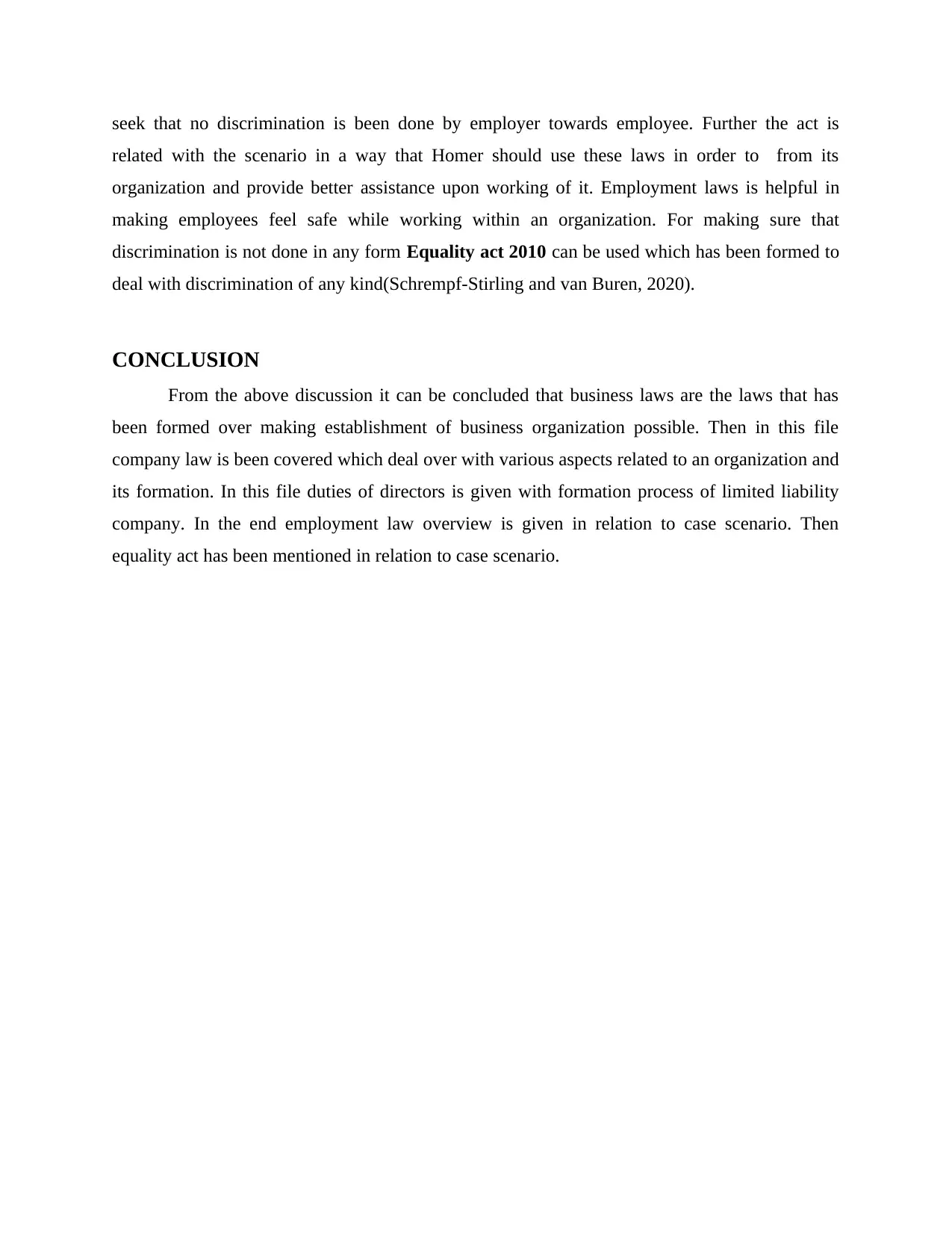
seek that no discrimination is been done by employer towards employee. Further the act is
related with the scenario in a way that Homer should use these laws in order to from its
organization and provide better assistance upon working of it. Employment laws is helpful in
making employees feel safe while working within an organization. For making sure that
discrimination is not done in any form Equality act 2010 can be used which has been formed to
deal with discrimination of any kind(Schrempf-Stirling and van Buren, 2020).
CONCLUSION
From the above discussion it can be concluded that business laws are the laws that has
been formed over making establishment of business organization possible. Then in this file
company law is been covered which deal over with various aspects related to an organization and
its formation. In this file duties of directors is given with formation process of limited liability
company. In the end employment law overview is given in relation to case scenario. Then
equality act has been mentioned in relation to case scenario.
related with the scenario in a way that Homer should use these laws in order to from its
organization and provide better assistance upon working of it. Employment laws is helpful in
making employees feel safe while working within an organization. For making sure that
discrimination is not done in any form Equality act 2010 can be used which has been formed to
deal with discrimination of any kind(Schrempf-Stirling and van Buren, 2020).
CONCLUSION
From the above discussion it can be concluded that business laws are the laws that has
been formed over making establishment of business organization possible. Then in this file
company law is been covered which deal over with various aspects related to an organization and
its formation. In this file duties of directors is given with formation process of limited liability
company. In the end employment law overview is given in relation to case scenario. Then
equality act has been mentioned in relation to case scenario.
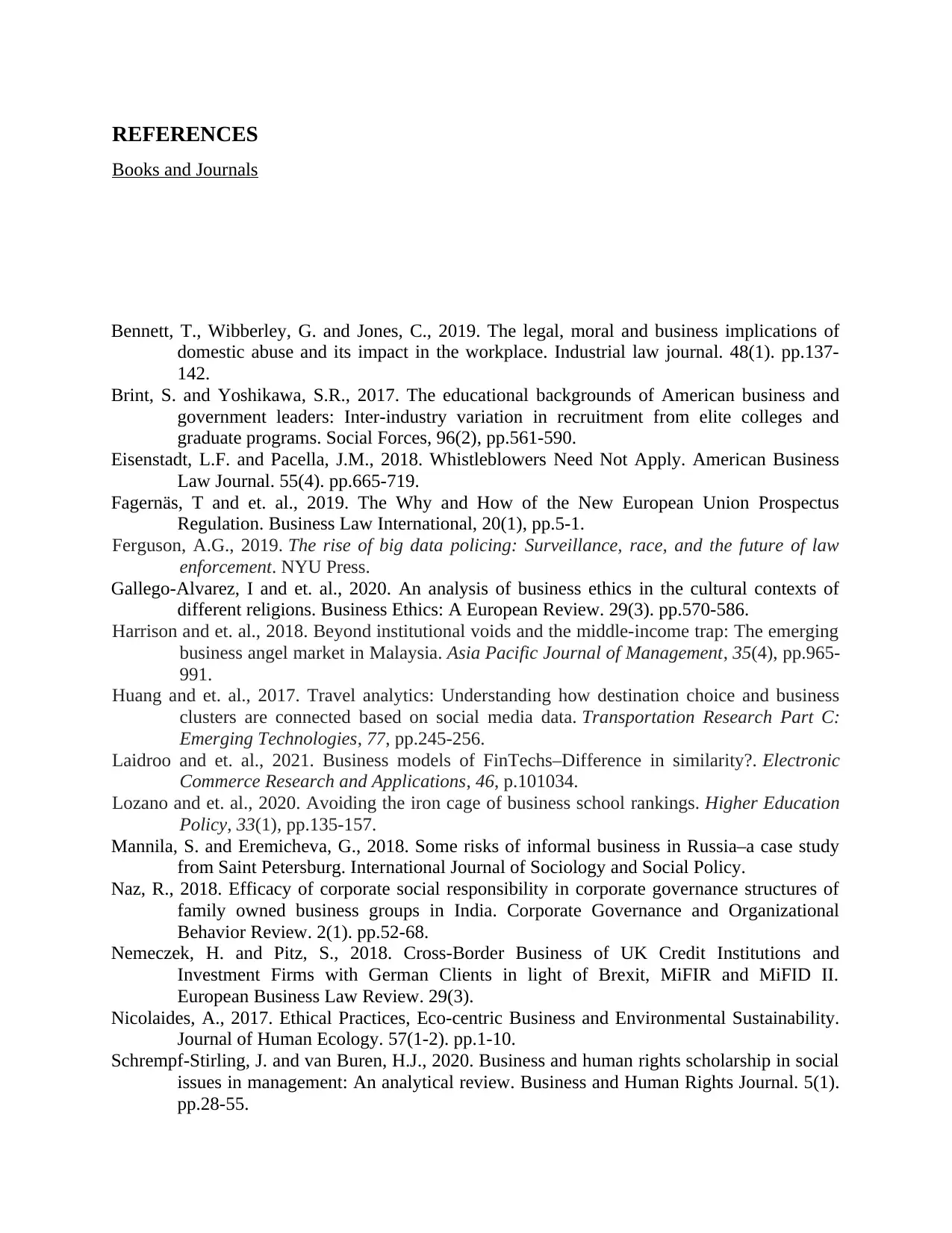
REFERENCES
Books and Journals
Bennett, T., Wibberley, G. and Jones, C., 2019. The legal, moral and business implications of
domestic abuse and its impact in the workplace. Industrial law journal. 48(1). pp.137-
142.
Brint, S. and Yoshikawa, S.R., 2017. The educational backgrounds of American business and
government leaders: Inter-industry variation in recruitment from elite colleges and
graduate programs. Social Forces, 96(2), pp.561-590.
Eisenstadt, L.F. and Pacella, J.M., 2018. Whistleblowers Need Not Apply. American Business
Law Journal. 55(4). pp.665-719.
Fagernäs, T and et. al., 2019. The Why and How of the New European Union Prospectus
Regulation. Business Law International, 20(1), pp.5-1.
Ferguson, A.G., 2019. The rise of big data policing: Surveillance, race, and the future of law
enforcement. NYU Press.
Gallego‐Alvarez, I and et. al., 2020. An analysis of business ethics in the cultural contexts of
different religions. Business Ethics: A European Review. 29(3). pp.570-586.
Harrison and et. al., 2018. Beyond institutional voids and the middle-income trap: The emerging
business angel market in Malaysia. Asia Pacific Journal of Management, 35(4), pp.965-
991.
Huang and et. al., 2017. Travel analytics: Understanding how destination choice and business
clusters are connected based on social media data. Transportation Research Part C:
Emerging Technologies, 77, pp.245-256.
Laidroo and et. al., 2021. Business models of FinTechs–Difference in similarity?. Electronic
Commerce Research and Applications, 46, p.101034.
Lozano and et. al., 2020. Avoiding the iron cage of business school rankings. Higher Education
Policy, 33(1), pp.135-157.
Mannila, S. and Eremicheva, G., 2018. Some risks of informal business in Russia–a case study
from Saint Petersburg. International Journal of Sociology and Social Policy.
Naz, R., 2018. Efficacy of corporate social responsibility in corporate governance structures of
family owned business groups in India. Corporate Governance and Organizational
Behavior Review. 2(1). pp.52-68.
Nemeczek, H. and Pitz, S., 2018. Cross-Border Business of UK Credit Institutions and
Investment Firms with German Clients in light of Brexit, MiFIR and MiFID II.
European Business Law Review. 29(3).
Nicolaides, A., 2017. Ethical Practices, Eco-centric Business and Environmental Sustainability.
Journal of Human Ecology. 57(1-2). pp.1-10.
Schrempf-Stirling, J. and van Buren, H.J., 2020. Business and human rights scholarship in social
issues in management: An analytical review. Business and Human Rights Journal. 5(1).
pp.28-55.
Books and Journals
Bennett, T., Wibberley, G. and Jones, C., 2019. The legal, moral and business implications of
domestic abuse and its impact in the workplace. Industrial law journal. 48(1). pp.137-
142.
Brint, S. and Yoshikawa, S.R., 2017. The educational backgrounds of American business and
government leaders: Inter-industry variation in recruitment from elite colleges and
graduate programs. Social Forces, 96(2), pp.561-590.
Eisenstadt, L.F. and Pacella, J.M., 2018. Whistleblowers Need Not Apply. American Business
Law Journal. 55(4). pp.665-719.
Fagernäs, T and et. al., 2019. The Why and How of the New European Union Prospectus
Regulation. Business Law International, 20(1), pp.5-1.
Ferguson, A.G., 2019. The rise of big data policing: Surveillance, race, and the future of law
enforcement. NYU Press.
Gallego‐Alvarez, I and et. al., 2020. An analysis of business ethics in the cultural contexts of
different religions. Business Ethics: A European Review. 29(3). pp.570-586.
Harrison and et. al., 2018. Beyond institutional voids and the middle-income trap: The emerging
business angel market in Malaysia. Asia Pacific Journal of Management, 35(4), pp.965-
991.
Huang and et. al., 2017. Travel analytics: Understanding how destination choice and business
clusters are connected based on social media data. Transportation Research Part C:
Emerging Technologies, 77, pp.245-256.
Laidroo and et. al., 2021. Business models of FinTechs–Difference in similarity?. Electronic
Commerce Research and Applications, 46, p.101034.
Lozano and et. al., 2020. Avoiding the iron cage of business school rankings. Higher Education
Policy, 33(1), pp.135-157.
Mannila, S. and Eremicheva, G., 2018. Some risks of informal business in Russia–a case study
from Saint Petersburg. International Journal of Sociology and Social Policy.
Naz, R., 2018. Efficacy of corporate social responsibility in corporate governance structures of
family owned business groups in India. Corporate Governance and Organizational
Behavior Review. 2(1). pp.52-68.
Nemeczek, H. and Pitz, S., 2018. Cross-Border Business of UK Credit Institutions and
Investment Firms with German Clients in light of Brexit, MiFIR and MiFID II.
European Business Law Review. 29(3).
Nicolaides, A., 2017. Ethical Practices, Eco-centric Business and Environmental Sustainability.
Journal of Human Ecology. 57(1-2). pp.1-10.
Schrempf-Stirling, J. and van Buren, H.J., 2020. Business and human rights scholarship in social
issues in management: An analytical review. Business and Human Rights Journal. 5(1).
pp.28-55.
⊘ This is a preview!⊘
Do you want full access?
Subscribe today to unlock all pages.

Trusted by 1+ million students worldwide
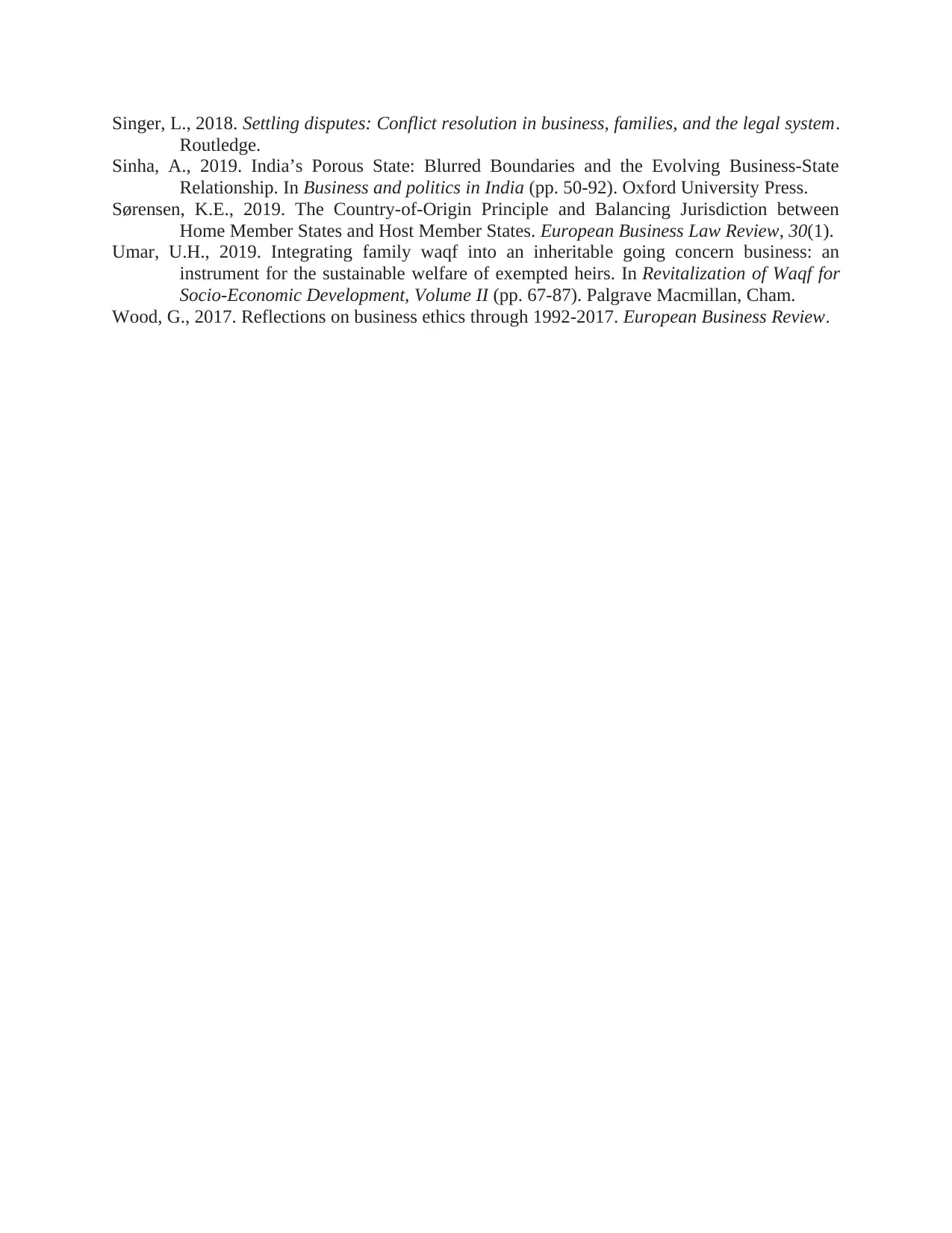
Singer, L., 2018. Settling disputes: Conflict resolution in business, families, and the legal system.
Routledge.
Sinha, A., 2019. India’s Porous State: Blurred Boundaries and the Evolving Business-State
Relationship. In Business and politics in India (pp. 50-92). Oxford University Press.
Sørensen, K.E., 2019. The Country-of-Origin Principle and Balancing Jurisdiction between
Home Member States and Host Member States. European Business Law Review, 30(1).
Umar, U.H., 2019. Integrating family waqf into an inheritable going concern business: an
instrument for the sustainable welfare of exempted heirs. In Revitalization of Waqf for
Socio-Economic Development, Volume II (pp. 67-87). Palgrave Macmillan, Cham.
Wood, G., 2017. Reflections on business ethics through 1992-2017. European Business Review.
Routledge.
Sinha, A., 2019. India’s Porous State: Blurred Boundaries and the Evolving Business-State
Relationship. In Business and politics in India (pp. 50-92). Oxford University Press.
Sørensen, K.E., 2019. The Country-of-Origin Principle and Balancing Jurisdiction between
Home Member States and Host Member States. European Business Law Review, 30(1).
Umar, U.H., 2019. Integrating family waqf into an inheritable going concern business: an
instrument for the sustainable welfare of exempted heirs. In Revitalization of Waqf for
Socio-Economic Development, Volume II (pp. 67-87). Palgrave Macmillan, Cham.
Wood, G., 2017. Reflections on business ethics through 1992-2017. European Business Review.
Paraphrase This Document
Need a fresh take? Get an instant paraphrase of this document with our AI Paraphraser

1 out of 11
Related Documents
Your All-in-One AI-Powered Toolkit for Academic Success.
+13062052269
info@desklib.com
Available 24*7 on WhatsApp / Email
![[object Object]](/_next/static/media/star-bottom.7253800d.svg)
Unlock your academic potential
Copyright © 2020–2025 A2Z Services. All Rights Reserved. Developed and managed by ZUCOL.





